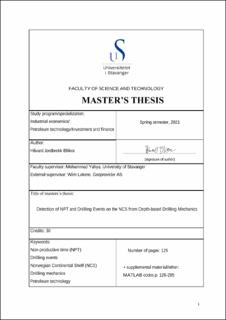| dc.contributor.advisor | Yahya, Mohammad. | |
| dc.contributor.advisor | Lekens, Wim. | |
| dc.contributor.author | Blikra, Håvard. | |
| dc.date.accessioned | 2021-09-29T16:30:19Z | |
| dc.date.available | 2021-09-29T16:30:19Z | |
| dc.date.issued | 2021 | |
| dc.identifier | no.uis:inspera:78874059:22337515 | |
| dc.identifier.uri | https://hdl.handle.net/11250/2786344 | |
| dc.description.abstract | Drilling events are subsurface related events that result in non-productive time (NPT) and increased costs. The aim of this thesis was to improve the understanding of drilling events to help mitigate non-productive time in drilling operations. NPT and drilling events related to drilling operations was studied and a consistent data analytics workflow in MATLAB was developed. An initial case study was conducted, and a prototype MATLAB workflow developed, testing different approaches for drilling events detection. Based on the result from the initial case study from the Northern North Sea, the workflow was updated and 20 wells from the North Sea and Norwegian Sea were analysed.
Mechanical specific energy and drilling strength models were calculated from depth-based drilling mechanics, and combined with the ratio between the two, the MSE/DS ratio, a workflow was created to detect drilling events. Based on cut-off values from the initial case study, the developed workflow enabled the detection of bit balling, vibrations, and bit wear. Unconfined compressive strength (UCS) was estimated from Sonic data and lithology, enabling the detection of hard rock.
Two methods were developed to estimate lost drilling time due to drilling events: The WOB-method and the Torque-method. Utilizing the linear relationship between ROP-WOB and Torque-WOB for efficient drilling, efficient bit-lines were created, enabling the estimation of lost drilling time due to inefficient drilling. By comparing bit changes to detected drilling events, lost time due to unplanned tripping was estimated.
The result from the initial case study showed a strong match between the reported events and the developed workflow. Among the 20 analysed wells, vibrations were the most common detected drilling event, with an average 41 m/km detected pr well. The largest contributor to NPT was bit balling, contributing to 44% of the lost time. On average, 69 hours were lost due to drilling events, equivalent to 5% of the total time for the drilling operations, with an estimated cost of 7 mill NOK.
The main advantage of the developed workflow is the ability to discover and map drilling events in offset wells from limited available data in an effectively manner, helping mitigate NPT in future wells. | |
| dc.description.abstract | Drilling events are subsurface related events that result in non-productive time (NPT) and increased costs. The aim of this thesis was to improve the understanding of drilling events to help mitigate non-productive time in drilling operations. NPT and drilling events related to drilling operations was studied and a consistent data analytics workflow in MATLAB was developed. An initial case study was conducted, and a prototype MATLAB workflow developed, testing different approaches for drilling events detection. Based on the result from the initial case study from the Northern North Sea, the workflow was updated and 20 wells from the North Sea and Norwegian Sea were analysed.
Mechanical specific energy and drilling strength models were calculated from depth-based drilling mechanics, and combined with the ratio between the two, the MSE/DS ratio, a workflow was created to detect drilling events. Based on cut-off values from the initial case study, the developed workflow enabled the detection of bit balling, vibrations, and bit wear. Unconfined compressive strength (UCS) was estimated from Sonic data and lithology, enabling the detection of hard rock.
Two methods were developed to estimate lost drilling time due to drilling events: The WOB-method and the Torque-method. Utilizing the linear relationship between ROP-WOB and Torque-WOB for efficient drilling, efficient bit-lines were created, enabling the estimation of lost drilling time due to inefficient drilling. By comparing bit changes to detected drilling events, lost time due to unplanned tripping was estimated.
The result from the initial case study showed a strong match between the reported events and the developed workflow. Among the 20 analysed wells, vibrations were the most common detected drilling event, with an average 41 m/km detected pr well. The largest contributor to NPT was bit balling, contributing to 44% of the lost time. On average, 69 hours were lost due to drilling events, equivalent to 5% of the total time for the drilling operations, with an estimated cost of 7 mill NOK.
The main advantage of the developed workflow is the ability to discover and map drilling events in offset wells from limited available data in an effectively manner, helping mitigate NPT in future wells. | |
| dc.language | eng | |
| dc.publisher | uis | |
| dc.title | Detection of NPT and Drilling Events on the NCS from Depth-based Drilling Mechanics | |
| dc.type | Master thesis | |
